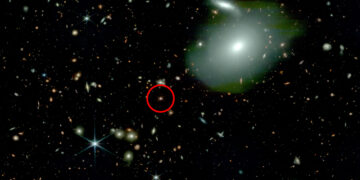Quasars have long captivated astronomers for their dazzling luminosity and their ability to unlock the secrets of the universe. Now, in an exciting breakthrough, a team of Chinese astronomers has identified 19 new quasars, a mix of strongly-lensed, dual, and projected quasars, using data from the DESI Legacy Surveys and the Palomar Observatory.
Quasars: Cosmic Powerhouses
Quasars, or quasi-stellar objects, are among the most luminous and distant objects in the universe. Powered by supermassive black holes at their centers, quasars emit intense electromagnetic radiation across multiple wavelengths, including radio, infrared, visible, ultraviolet, and X-rays. They serve as invaluable tools for studying the large-scale structure of the cosmos and understanding the evolution of galaxies.
When astronomers observe quasars, they sometimes encounter objects that appear as pairs or clusters. These configurations fall into three categories:
- Strongly-lensed quasars, where light from a single quasar is bent by the gravitational field of a massive object, creating multiple images of the same quasar.
- Dual quasars, which are physically interacting systems of two quasars at similar redshifts.
- Projected quasars, which appear close together due to line-of-sight alignment but are actually at different redshifts.
The Breakthrough Discovery
In their recent study, astronomers from the Purple Mountain Observatory in China identified 19 new quasars using the DESI Legacy Surveys photometry catalog. These candidates were then observed at the Palomar Observatory using the P200/DBSP instrument, confirming their classification:
- 2 strongly-lensed quasars (J0746+1344 and J2121-0826)
- 6 dual quasars
- 11 projected quasars
This discovery represents a significant advancement in quasar research, providing valuable data to explore these enigmatic objects further.
The Science Behind the Discovery
The researchers employed sophisticated tools and techniques to identify and classify these quasars. Using the DESI Legacy Surveys photometry catalog, they selected high-priority quasar candidates based on specific characteristics. The subsequent observations at Palomar provided spectral data to confirm their nature.
For instance, one of the lensed quasars, J0746+1344, exhibited a strong flux anomaly, with its lensing galaxy positioned unusually close to the brightest image. Such anomalies offer rare opportunities to study gravitational lensing in detail. Similarly, the dual quasars identified showed projected separations ranging from 50,300 to 73,500 light-years, suggesting complex galactic interactions.
Why This Discovery Matters
Unlocking the Mysteries of Gravitational Lensing
The study of strongly-lensed quasars is crucial for understanding gravitational lensing, a phenomenon predicted by Einstein’s theory of general relativity. These systems allow astronomers to map the distribution of dark matter in the universe, as the lensing effect is directly influenced by the mass of the intervening object.
Tracing Galactic Evolution
Dual quasars provide a unique window into the processes of galactic mergers and interactions. By examining these systems, scientists can gain insights into how galaxies evolve and the role of supermassive black holes in shaping their host galaxies.
Shedding Light on Dark Matter
Projected quasars, though not physically related, offer opportunities to study dark matter distribution along the line of sight. The alignment of these quasars with intervening galaxies can reveal the gravitational influence of unseen matter, advancing our understanding of one of the universe’s greatest mysteries.
Challenges and Unanswered Questions
Despite its significance, the discovery also raises several challenges and questions. Distinguishing between lensed and projected quasars can be difficult without detailed follow-up observations. The unusual configuration of J0422+0047, initially thought to be a lensed system but now believed to involve a complex alignment, highlights the need for more precise data.
Additionally, the nature of dual quasars and their role in galaxy formation remain areas of active investigation. How do these systems evolve over time? What triggers the formation of dual quasars? These are questions that future research aims to address.
The Road Ahead: Future Research and Observations
The study of these newly discovered quasars is far from over. Upcoming observatories, such as the James Webb Space Telescope (JWST) and the Vera C. Rubin Observatory, promise to provide higher-resolution data and deeper insights into these systems. Advanced computational techniques, including machine learning, will also play a pivotal role in identifying and analyzing quasars more efficiently.
Moreover, ongoing surveys like DESI will continue to uncover new quasar candidates, expanding our knowledge of these fascinating objects and their significance in the cosmic landscape.
Conclusion
The discovery of 19 new lensed, dual, and projected quasars marks a significant milestone in astronomy, offering fresh opportunities to explore the universe’s most luminous and enigmatic objects. By advancing our understanding of quasars, gravitational lensing, and galactic interactions, this research not only enriches our knowledge of the cosmos but also inspires new questions and avenues for exploration. As we look to the future, the study of quasars will undoubtedly remain a cornerstone of astrophysical research, illuminating the mysteries of the universe and our place within it.
Reference:
Zizhao He et al, Discovery of 19 strongly-lensed quasars, dual and projected quasars in DESI-LS, arXiv (2025). DOI: 10.48550/arxiv.2501.08541



















